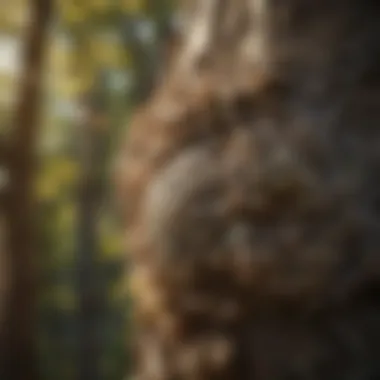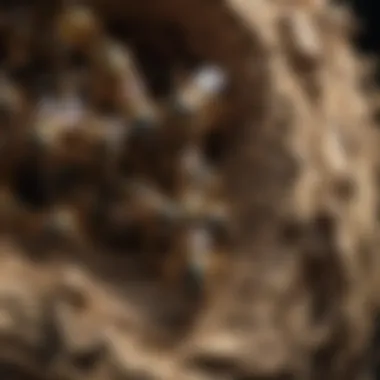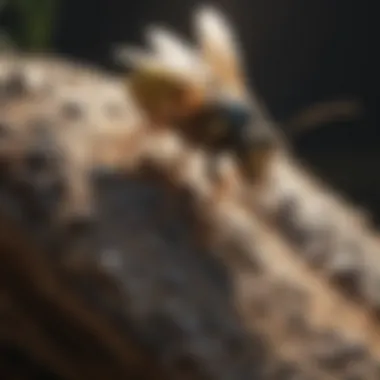Effective Strategies for Wasp Nest Removal


Intro
By gaining insight into wasp behavior and the risks associated with their nests, homeowners can approach pest control with confidence. This can lead not only to safe removal but also to preventing future infestations.
Pest Identification
Identifying wasps correctly is vital for effective pest management. Common wasp species include the Yellow Jackit, Paper Wasp, and Hornet. Each species has distinctive features and behaviors.
Detailed Descriptions of Common Pests
- Yellow Jacket: Recognizable by its black and yellow markings, it has a somewhat robust body and is often found in gardens and near food sources.
- Paper Wasp: This species has elongated bodies and typically builds open, umbrella-shaped nests under eaves or on branches.
- Hornet: Usually larger than the average wasp, hornets have a more rounded body and can be aggressive when threatened.
Signs and Symptoms of Infestations
Homeowners should watch for certain indicators of wasp infestations. Key signs include:
- Increased wasp activity around trash cans or outdoor seating areas.
- Visible nests in trees, bushes, or eaves.
- Stings or sightings on property can signal nearby nests.
Recognizing these signs early can help avoid escalation and potential injury.
Prevention Strategies
Proactive measures can significantly reduce the likelihood of wasp infestations. Simple maintenance steps can make homes less inviting.
Home Maintenance Tips for Pest Prevention
- Seal any cracks or holes in walls and foundations.
- Dispose of garbage regularly and keep cans tightly sealed.
- Cover food outdoors and clean up spills immediately.
Natural Deterrents and Barriers
Certain plants can act as natural repellents, such as:
- Mint: Planting mint around the home can deter wasps.
- Cucumber: Pieces of cucumber placed in outdoor areas can also keep wasps away.
Implementing these strategies can help create a less appealing environment for wasps.
Treatment Options
When removal becomes necessary, understanding treatment options is critical. Both natural and chemical treatments are available, each with its own advantages.
Overview of Chemical vs. Natural Treatments
Chemical treatments are often more immediate, but they carry hazards. In contrast, natural methods may take longer but are safer for the environment and pets.
- Chemical Treatments: Ready-to-use insecticides can be effective in killing wasps quickly. However, caution is necessary to avoid exposure.
- Natural Treatments: Solutions such as soap and water can also be effective against nests.
Step-by-Step Guides for DIY Treatments
Chemical Treatment:
- Purchase a quality insecticide designed for wasps.
- Wear protective clothing, including gloves and goggles.
- Follow the manufacturer’s instructions closely, applying during evening when wasps are less active.
- Remove the nest when it is completely inactive.
Natural Treatment:
- Mix water and dish soap in a spray bottle.
- Approach the nest cautiously at dusk.
- Spray the mixture thoroughly onto the nest.
- Monitor the area until all wasps are gone.
It's advisable to consider professional removal for larger nests or aggressive species.
Equipping oneself with proper knowledge and strategies can aid in tackling wasp problems effectively and safely.
Understanding Wasp Behavior
Understanding wasp behavior is crucial for effective nest removal and ensuring safety. Knowledge about their habits and characteristics allows homeowners to assess the situation better and make informed decisions. This section covers essential aspects of wasps, including species identification, their lifecycle, and associated risks.
Wasp Species Identification
Identifying the wasp species is the first step in dealing with a nest. Common types include the yellow jacket, paper wasp, and hornet. Yellow jackets are known for their aggressive behavior, especially when their nests are threatened. They tend to nest in wall cavities and underground.


Paper wasps, with their distinctive umbrella-shaped nests, are generally less aggressive but can still sting. Hornets, which are larger, often create a large aerial nest. Proper identification helps determine the best removal strategy and the level of caution needed during the process.
When dealing with wasps, research specific species or consult local pest control resources for accurate identification. This can be done through online platforms like Wikipedia or community forums on Reddit.
Lifecycle of Wasps
Understanding the lifecycle of wasps is vital in planning removal efforts. Wasps go through four stages: egg, larva, pupa, and adult. In spring, a fertilized queen emerges from hibernation and begins to build a nest, laying eggs that develop into workers.
The nest will grow throughout summer, with the queen continuing to produce more female worker wasps. By late summer, the nest reaches its peak population. As autumn arrives, new queens are born, and the cycle continues. Knowing this lifecycle empowers homeowners to time their removal efforts effectively. Notably, early spring removals can prevent infestations from establishing fully.
Risk Factors Associated with Wasps
Encountering wasps poses several risks. Stinging incidents can lead to allergic reactions, some of which may require emergency treatment. Being aware of factors such as aggressive species, proximity to nests, and the time of year is important.
Moreover, certain activities can increase the likelihood of confrontations. For example, outdoor activities like picnics can attract wasps, especially when food is present. Homeowners should stay vigilant and recognize signs of nests to mitigate potential hazards.
Assessing the Situation
Assessing the situation before attempting to remove a wasp nest is crucial for both safety and effectiveness. This process involves understanding where the nests are located and how active they are. Proper assessment can help in selecting the right removal strategy and avoiding unnecessary encounters with wasps. Many people underestimate the importance of this phase, but being informed and prepared can make a significant difference in the outcome.
Locating Wasp Nests
Finding wasp nests requires keen observation and attention to detail. Wasps typically choose hidden spots for their nests, such as eaves, attics, and dense shrubbery. Here are steps to effectively locate a wasp nest:
- Look for wasp activity: Observe wasps flying back and forth. They often have a direct flight path to and from their nests. Monitoring their routes can lead to the nest's location.
- Check common nesting sites: Inspect areas like garages, sheds, or under decks. These places provide shelter and protection.
- Use of visual cues: Wasps can create noticeable nests. Some nests are large and easily spotted, while others might be less conspicuous.
By paying attention to these signs, homeowners can efficiently identify the nests that require removal.
Evaluating Nest Size and Activity
Once a nest is located, it is vital to evaluate its size and level of activity. Understanding these elements directly affects the decision on how to proceed with removal. The size of a nest indicates the number of wasps present, which can influence the method of removal.
- Small nests: These might contain fewer wasps and can often be dealt with using simpler removal methods or natural solutions.
- Large nests: Bigger nests indicate a larger population. This may necessitate stronger chemical solutions or professional assistance.
- Activity level: Monitoring the nest for a day or two allows one to assess the wasps' behavior. High activity could suggest that the nest’s removal is urgent, while low activity might permit a more cautious approach.
"Taking the time to evaluate a nest can save you from unpleasant surprises and ensure a safer removal process."
Overall, effective assessment of the situation lays the groundwork for a successful wasp nest removal strategy. It promotes preparedness, minimizes risks, and enhances the probability of a seamless process.
When to Remove a Wasp Nest
Removing a wasp nest is not a decision that should be made lightly. Timing is critical, as it can affect your safety and the effectiveness of the removal. Understanding when to act has significant implications, as a hasty approach might escalate the risk of stings or cause harm to the ecosystem. It is essential to assess the situation thoroughly before proceeding. Proper timing allows for a strategic response, minimizing danger while maximizing efficiency in wasp nest removal. Here, we explore timing considerations for removal, alongside signs that indicate an active nest.
Timing Considerations
The timing of wasp nest removal plays a vital role in achieving a successful outcome. Wasps are generally most active in the late spring and early summer when their populations grow rapidly. Approaching removal during this period may be more dangerous due to the large number of wasps present. Therefore, waiting until late summer or early fall, when wasp activity tends to decrease, is often more strategic. However, it must be noted that by this time, the nests could be quite large, presenting challenges for safe removal.
- Assess the local climate, as cooler temperatures might reduce wasp activity. Removing nests in the evening or early morning, when wasps are less active, is particularly advisable.
Moreover, observing the weather can guide your removal plan. Rainy or windy forecasts often lead wasps into their nests, making removal less hazardous. Prior planning can mitigate risks significantly. Additionally, consider your own comfort level with handling such situations, as untrained individuals may prefer to seek professional help during high-risk periods.
Signs of an Active Nest
Identifying an active wasp nest is key before deciding to remove it. Here are some signs to look for:
- Increased Wasp Activity: Noticing a frequent number of wasps entering and exiting a particular area often indicates an active nest.
- Nesting Material: Wasps typically use chewed wood fibers and their saliva to create nests. If you see paper-like material, this can confirm a nearby nest.
- Aggressive Behavior: If wasps are exhibiting defensive behaviors, such as flying aggressively toward disturbances, this is a clear sign that their nest may be nearby.
To ensure safety, it’s best to observe from a distance before getting too close.
- Audible Sounds: Occasionally, you might hear a buzzing sound, especially near the nest entrance, which suggests active wasps.
Preventative Measures
Preventative measures play a crucial role in minimizing the risk of wasp infestations around the home. It is much easier and safer to take steps to discourage wasps than to remove them once they have established a nest. Homeowners can implement small changes in their environment and habits to effectively reduce the allure for wasps. This section will outline effective strategies in this regard, discussing both environmental modifications and methods for attracting and deterring these insects.
Environmental Modifications
Changing the surroundings can significantly decrease the chances of attracting wasps to your property. Here are some strategies to consider:


- Seal entry points: Inspect the exterior of your home for gaps, cracks, or holes. Sealing these openings not only prevents wasps from nesting but also helps with other pests.
- Remove food sources: Wasps are attracted to sugary substances and food residues. Regularly clean trash cans and ensure that outdoor waste is sealed tightly. Additionally, secure pet food and do not leave it outside.
- Maintain garden hygiene: Overripe fruits and fallen debris can act as beacons for wasps. Regularly picking fruits from trees and cleaning up fallen leaves and vegetation makes your garden less inviting.
- Use proper landscaping: Planting certain plants can either attract or repel wasps. For instance, consider integrating herbs such as mint and basil that repel wasps while planting other flowering plants strategically.
By making these modifications, homeowners can create a less inviting environment for wasps, thus decreasing the likelihood of nest formation nearby.
Attracting and Deterring Wasps
Understanding how to both attract and repel wasps can be beneficial in managing their presence. The following methods can be implemented:
- Decoy Nests: Wasps are territorial and will frequently avoid areas where other nests exist. Hang a decoy wasp nest to deter real wasps from moving in. This simple trick can significantly lower the risk of new nests in your vicinity.
- Use of Traps: Using wasp traps can help manage populations. These traps work by luring wasps with sweet liquids and trapping them. Ensure traps are placed away from frequently used areas to avoid attracting wasps.
- Natural Deterrents: Certain essential oils, like peppermint, can repel wasps. Creating a spray with water and peppermint oil to apply around outdoor seating areas can help keep them away.
"The best way to avoid an issue with wasps is to keep them from being attracted in the first place. Prevention is key to effective wasp management."
- Strategic Food Placement: If having outdoor meals or gatherings, cover food immediately to minimize exposure. Dispose of any leftovers quickly and clean up spills that might attract them.
By implementing these strategies, homeowners can create conditions less favorable for wasps and successfully circumvent infestations before they begin.
Methods for Removal
Understanding the different methods for wasp nest removal is crucial for anyone dealing with an infestation. Each method presents its own set of advantages and considerations. The effectiveness of these methods can vary based on factors like nest size, location, and the type of wasp species involved. Choosing the right approach is not only important for successful removal but also for ensuring safety during the process.
Using Chemical Solutions
Chemical solutions are a common choice for wasp nest removal. They often provide immediate results, which is appealing for homeowners facing aggressive wasps. Products containing pyrethroids are particularly effective because they simulate natural insecticides produced by chrysanthemum flowers. These chemicals act quickly, often paralyzing the wasps almost instantly.
However, while using chemical solutions, one must be cautious. It's critical to follow all manufacturer instructions closely to ensure effectiveness and safety. Applying these sprays at dusk or dawn, when wasps are less active, increases the chances of effective treatment. Moreover, consider wind direction to avoid the spray affecting yourself or nearby non-target species.
Pros of chemical solutions include:
- Quick action against wasps.
- Generally high effectiveness for large nests.
- Available in most home improvement stores.
Cons include:
- Potential harm to beneficial insects if not used carefully.
- Some users report lingering chemical smells.
- Not eco-friendly if overused.
Natural Removal Techniques
Natural removal techniques are gaining popularity among those who prefer eco-friendly approaches. These methods typically rely on non-toxic substances or even physical barriers to deter wasps from settling in certain areas. Some commonly recommended natural deterrents include:
- Peppermint Oil: Mixed with water and sprayed near the nest, peppermint oil can repel wasps due to its strong scent.
- Soap and Water: A mixture can effectively kill wasps by clogging their breathing pores.
- Fake Nests: Hanging up so-called decoy nests can discourage new wasps from establishing their colonies, as they tend to avoid areas that appear already inhabited.
Natural solutions are appealing because they lessen the environmental impact. However, they may require repeated applications and can sometimes take longer to show results. Effectiveness can also vary depending on the severity of the infestation and local wasp behavior.
Professional Pest Control Services
When home remedies and chemical solutions fall short, seeking professional pest control services is a reliable option. Pest control experts have access to specialized equipment and training, which allow for more thorough and safe nest removals. They can also identify the type of wasp and recommend tailored strategies proportional to the infestation.
Choosing a professional service is helpful because:
- They assess risks and determine the best removal method based on their experience.
- Professionals often ensure that the removal process adheres to local regulations regarding pesticides and wildlife.
- They offer preventative marks to diminish the chances of future infestations.
However, this option can be more costly than self-removal techniques. Homeowners should research pest control companies, reading reviews and confirming their certifications to ensure they hire reliable services.
In summary, methods for wasp nest removal vary widely, each with strengths and weaknesses. Understanding these methods enables homeowners to make informed decisions based on their specific situations, prioritizing safety and effectiveness.
Safety Precautions
When considering wasp nest removal, ensuring safety should be the utmost priority. Wasps can be aggressive, especially when their nest is disturbed. A calculated approach protects you not only from potential stings but also from other risks related to removal methods. Proper safety precautions can significantly reduce the likelihood of injury and ensure a smooth process in any wasp removal endeavor.
Protective Gear Recommendations
Choosing the right protective gear is crucial before attempting to remove a wasp nest. Here are some recommended items:
- Long Sleeves and Pants: Wear thick clothing that covers all skin surfaces. This adds a layer of protection against stings.
- Gloves: Use leather or heavy-duty gloves to prevent wasps from stinging your hands.
- Face Protection: A face shield or veil can protect your face from frenzied wasps that might get too close.
- Footwear: Sturdy boots or shoes that cover the ankles can provide additional protection while working around the nest.
"Proper gear can minimize the risk of stings, which allows for safer removal efforts."
Wearing these items may not completely guarantee safety, but they will help diminish the chance of being stung. Evaluate your surroundings and dress according to the risk level present in your area.


Emergency Response Information
Preparedness for potential emergencies is another essential aspect of wasp nest removal. In cases of sting reactions or injuries, acting quickly can make a significant difference. Here’s a brief guide on what to do:
- Identify Allergies: Know if you or anyone nearby is allergic to wasp stings. Carry an epinephrine auto-injector if necessary.
- Seek Shelter: If wasps become aggressive, leave the area immediately to avoid further stings.
- First Aid: For minor stings, clean the area with soap and water. Apply ice to reduce swelling and discomfort.
- Call Emergency Services: If someone suffers a severe allergic reaction, facts such as difficulty breathing or swelling in the throat, contact emergency services immediately.
Keeping a first-aid kit readily available can be helpful. It should contain:
- Antihistamines
- Ice pack
- Bandages
- First-aid cream
Ensuring that you have a plan in place for emergencies can provide peace of mind while addressing a wasp nest removal task.
Post-Removal Considerations
After successfully removing a wasp nest, it is essential to address post-removal considerations to ensure a complete resolution to the issue. Ignoring these steps can lead to the reemergence of wasps and compromise the safety of your environment. Effective post-removal strategies help maintain a wasp-free area and protect against future infestations.
Clearing the Area
Once the nest is removed, the first step is to clear the area around the site. This involves removing any debris or materials that could attract other wasps or pests. Wasps are drawn to food sources, so ensure that all food waste, pet food, and other organic materials are cleaned up.
- Check your property thoroughly:
- Inspect gardens, trash cans, and picnic areas for leftover food.
- Clean up spills and leftover drinks that might attract them.
Additionally, because wasps often return to previously established nesting sites, it is crucial to eliminate potential nesting spots.
- Look for:
- Hollow trees
- Wall voids
- Roof overhangs or attics
Make sure that these areas are sealed off. Both reducing attractants and sealing potential nests can significantly decrease the chance of future infestations.
Monitoring for New Nests
Monitoring for new nests is a crucial follow-up after removal. Wasps can reinvade an area quickly if conditions are conducive. By keeping an eye on the surroundings, you can catch new nest establishments early, making removal much easier.
- Conduct regular inspections of common nesting areas, such as:
- Be watchful during late summer and early fall when wasp activity peaks. If you spot any new nests forming, take action immediately to remove them while they are still small and manageable.
- Eaves
- Sheds
- Under decks
Regular monitoring can save you time and trouble. Early detection allows for proactive removal, reducing the risk of dangerous encounters.
In summary, understanding post-removal considerations, such as clearing the area and monitoring for new nests, is vital for long-term pest management. Prioritizing these factors lowers the chances of wasp reestablishment and enhances the safety of your home.
Common Myths and Misconceptions
Understanding the common myths and misconceptions surrounding wasps is crucial. This knowledge helps homeowners make informed decisions regarding nest removal and pest control. Many of these myths create unnecessary fear or misunderstanding about the nature of wasps, which affects how people react to infestations.
A clear understanding of what is true and what is false can lead to better prevention strategies and safer removal techniques. By debunking myths, we can reduce panic and promote a more rational approach to dealing with wasps.
Debunking Myths about Wasps
Many people believe that all wasps are aggressive and will attack without provocation. In reality, only the female wasps sting, and they typically do so in defense of their nest. Wasps are not naturally hostile but will protect their colony if they feel threatened. Understanding their behavior can greatly reduce unnecessary fear.
Another common myth is that wasps do not contribute positively to our environment. This is incorrect. Wasps play essential roles in their ecosystems, such as pollination and pest control. They help manage the populations of harmful insects, making them beneficial in natural pest management.
Here are some prevalent myths and the truths behind them:
- Myth: All wasps are dangerous.
Truth: Only certain species pose risks; many are harmless and beneficial. - Myth: Wasps will follow you or seek revenge after a sting.
Truth: Wasps do not have a vendetta; they react to danger and defend their nest. - Myth: You should get rid of all wasps.
Truth: Some species are helpful for gardens and ecosystems.
Understanding Wasp Role in Ecosystem
Wasps are often misunderstood creatures. While they can pose a risk when their nests are disturbed, they also play significant roles in our ecosystems. It is vital to recognize their contributions.
- Pollinators: Just like bees, many wasps help in the process of pollination. They aid the fertilization of flowers, promoting plant reproduction.
- Pest Controllers: Wasps naturally regulate insect populations by preying on caterpillars and other pests, contributing to ecological balance.
- Food Source for Other Animals: Wasps serve as food for various birds, mammals, and other insects, forming a part of the food web.
Culmination
When considering wasp removal, timing plays an important role. Recognizing the signs of an active nest can significantly enhance the safety of removal efforts. Additionally, preventative measures can greatly reduce the likelihood of future infestations. By modifying the environment to deter wasps, homeowners can contribute to long-term solutions rather than temporary fixes.
Moreover, safety precautions cannot be overlooked. Proper protective gear and emergency response information are instrumental in safeguarding those involved in removal efforts. Post-removal actions, such as monitoring for new nests, can further ensure that the issue is effectively resolved.
"The key to successful wasp nest removal lies not just in the act itself but in understanding and preventing future occurrences."
Finally, debunking common myths surrounding wasps helps in fostering a better relationship with these insects. Understanding their role in the ecosystem allows homeowners to appreciate their benefits as pollinators while maintaining a safe living environment. By following the comprehensive strategies outlined, one can not only address current infestations but also build a foundation for ongoing safety and peace in their home.



